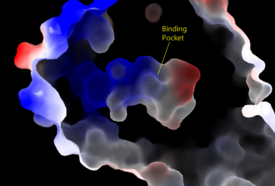Sandbox Reserved 1789
From Proteopedia
(Difference between revisions)
| Line 21: | Line 21: | ||
<scene name='95/952717/Shoc2/1'>SHOC2</scene> is a scaffold protein composed of 20 [https://www.ncbi.nlm.nih.gov/pmc/articles/PMC3901792/. leucine-rich repeat (LRR)] domains that form a solenoid structure <ref name="Hauseman"/>. The leucine rich region forms a concave hydrophobic core which is necessary for binding with PP1C and MRAS. SHOC2 is the crucial mediator for SHOC2-PP1C-MRAS complex formation <ref name="Hauseman"/>. The leucine rich domain is very important in creating selectivity for the PP1C protein, as that protein is used for so many other complex pathways <ref name="Hauseman"/>. The LRR domains are stabilized by an N-terminal flanking 𝝰-helix and a C-terminal helix-turn-helix <ref name="Kwon">PMID:35831509</ref>. Alongside the conserved leucine residues in the LRR domain, there is a group of conserved asparagine residues that creates a stabilizing [https://www.ncbi.nlm.nih.gov/pmc/articles/PMC7184636/. “asparagine ladder”] that is necessary for the LRR fold, giving the SHOC2 its concave structure <ref name="Kwon" />. | <scene name='95/952717/Shoc2/1'>SHOC2</scene> is a scaffold protein composed of 20 [https://www.ncbi.nlm.nih.gov/pmc/articles/PMC3901792/. leucine-rich repeat (LRR)] domains that form a solenoid structure <ref name="Hauseman"/>. The leucine rich region forms a concave hydrophobic core which is necessary for binding with PP1C and MRAS. SHOC2 is the crucial mediator for SHOC2-PP1C-MRAS complex formation <ref name="Hauseman"/>. The leucine rich domain is very important in creating selectivity for the PP1C protein, as that protein is used for so many other complex pathways <ref name="Hauseman"/>. The LRR domains are stabilized by an N-terminal flanking 𝝰-helix and a C-terminal helix-turn-helix <ref name="Kwon">PMID:35831509</ref>. Alongside the conserved leucine residues in the LRR domain, there is a group of conserved asparagine residues that creates a stabilizing [https://www.ncbi.nlm.nih.gov/pmc/articles/PMC7184636/. “asparagine ladder”] that is necessary for the LRR fold, giving the SHOC2 its concave structure <ref name="Kwon" />. | ||
| + | SHOC2 is also capable of causing various forms of Rasopathies. A common one is caused by a mutation known as p.S2G <ref name="Rauen">Rauen KA. The RASopathies. Annu Rev Genomics Hum Genet. 2013;14:355-69. [http://dx.doi.org/10.1146/annurev-genom-091212-153523 doi: 10.1146/annurev-genom-091212-153523.]</ref>. This mutation causes the formation of an additional 14-carbon saturated fatty acid chain on the N-terminal glycine of SHOC2 <ref name="Rauen" />. This causes SHOC2 to become attached to the cell membrane, resulting in a prolonged dephosphorylation of RAF by PP1C <ref name="Rauen" />. With this abnormality, there is overexpression of the MAPK pathway and increased cell proliferation genes <ref name="Rauen" /> | ||
=== PP1C === | === PP1C === | ||
Revision as of 18:00, 19 April 2023
This page, as it appeared on June 14, 2016, was featured in this article in the journal Biochemistry and Molecular Biology Education.
SHOC2-PP1C-MRAS
| |||||||||||
Student Contributors
Madeline Gilbert Inaya Patel Rushda Hussein



